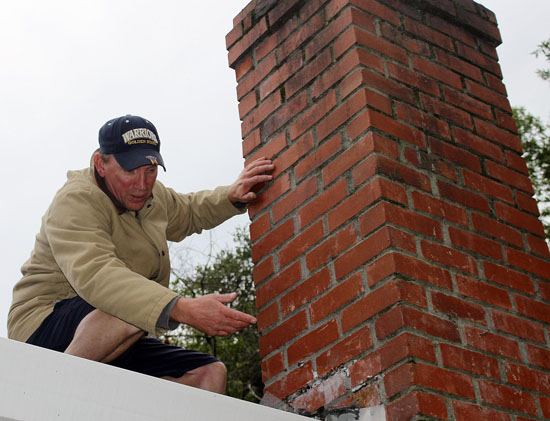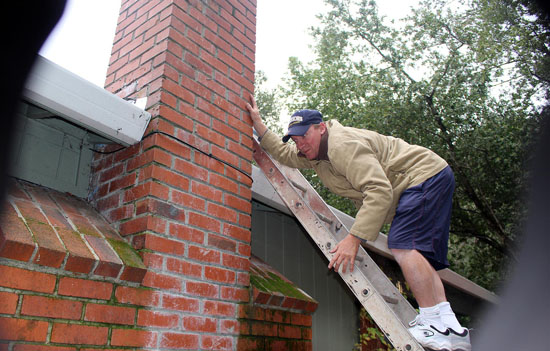 | | | Unseen water can get in between the cracks in the mortar, freeze, and loosen the bricks, making them unstable. Photo Chris Lavin | | | | | | Kids learn it when they're knee high from the wolf in the fable "The Three Little Pigs." The wolf huffs and he puffs and he blows the first two houses down with little effort, and gobbles two little pigs right up. So much for the inhabitants protected by straw and wood. But the third, the brick structure, the wolf cannot shake. Ergo, brick is the best construction material if you want to stay safe, right? The author (who was British, sniff) obviously wasn't living in earthquake country.
 While brick is not a prime building material here any longer - it's not even allowed any more for new chimney construction anywhere in the state - brick chimneys are ubiquitous among Lamorinda's older homes, along with their brick walls, fences and other structures that could topple in a temblor. Construction experts say that as long as homeowners pay attention to upkeep, older structures shouldn't be too much of a threat when the next "Big One" hits.
While brick is not a prime building material here any longer - it's not even allowed any more for new chimney construction anywhere in the state - brick chimneys are ubiquitous among Lamorinda's older homes, along with their brick walls, fences and other structures that could topple in a temblor. Construction experts say that as long as homeowners pay attention to upkeep, older structures shouldn't be too much of a threat when the next "Big One" hits.
 "You have to inspect," said Mike Fay of Mike's Mobile Screen and Chimney Service. He's not doing much work in Lamorinda now because of the quake last year that took out most of Napa's downtown and a lot of Vallejo. His crews are up there, still busy. Bricks galore tumbled into the streets. Thank goodness it happened in the middle of the night when a lot of people were not wandering the streets, Fay said. "It's a lot of work up there right now, but people can prevent this sort of thing."
"You have to inspect," said Mike Fay of Mike's Mobile Screen and Chimney Service. He's not doing much work in Lamorinda now because of the quake last year that took out most of Napa's downtown and a lot of Vallejo. His crews are up there, still busy. Bricks galore tumbled into the streets. Thank goodness it happened in the middle of the night when a lot of people were not wandering the streets, Fay said. "It's a lot of work up there right now, but people can prevent this sort of thing."
 That means you need to know what you have. "What happens is that people who have brick chimneys really need to be on top of their inspections," he said. "When the house shakes, the chimney doesn't necessarily need to shake with it." Brick strikes are dangerous and, above head height, can be deadly. "One brick and that could be fatal."
That means you need to know what you have. "What happens is that people who have brick chimneys really need to be on top of their inspections," he said. "When the house shakes, the chimney doesn't necessarily need to shake with it." Brick strikes are dangerous and, above head height, can be deadly. "One brick and that could be fatal."
 Fay recommends an annual inspection of anything brick. "Most people who use their chimneys regularly do get inspected," he said. The primary reason for malfunction, he said, is unseen - water gets in between the cracks in the mortar, freezes, loosens the bricks and makes them unstable. One earthquake, and they tumble.
Fay recommends an annual inspection of anything brick. "Most people who use their chimneys regularly do get inspected," he said. The primary reason for malfunction, he said, is unseen - water gets in between the cracks in the mortar, freezes, loosens the bricks and makes them unstable. One earthquake, and they tumble.
 Another hazard, he said, is listening to people who say that a chimney should be attached to a house. "I see rebar, I see straps attaching chimneys to houses," he said. "That's a mistake. A chimney is not attached to the house because a chimney is detached from the house. It's separate. When someone attaches the chimney to the house, in an earthquake that's going to make the chimney fall. Those straps will make the chimney shake with the house, and that shouldn't happen."
Another hazard, he said, is listening to people who say that a chimney should be attached to a house. "I see rebar, I see straps attaching chimneys to houses," he said. "That's a mistake. A chimney is not attached to the house because a chimney is detached from the house. It's separate. When someone attaches the chimney to the house, in an earthquake that's going to make the chimney fall. Those straps will make the chimney shake with the house, and that shouldn't happen."
 Therefore, do not attach the chimney to the house, Fay says.
Therefore, do not attach the chimney to the house, Fay says.
 "Nobody is using brick for chimneys anymore," said Dylan Llewellyn of Canyon. "You can catch problems early but otherwise you're outta luck." Fay agrees.
"Nobody is using brick for chimneys anymore," said Dylan Llewellyn of Canyon. "You can catch problems early but otherwise you're outta luck." Fay agrees.
 "The best thing is to catch any problem early," Fay said. "You can have structural or water damage. It's easiest to catch it early, otherwise it will have to be rebuilt." Nowadays that is done by replacing brick chimneys with pre-fab metal and wood chimneys that are built to live atop modern foundations and within houses that will pretend to have brick chimneys, so that Santa Claus next year still feels welcome.
"The best thing is to catch any problem early," Fay said. "You can have structural or water damage. It's easiest to catch it early, otherwise it will have to be rebuilt." Nowadays that is done by replacing brick chimneys with pre-fab metal and wood chimneys that are built to live atop modern foundations and within houses that will pretend to have brick chimneys, so that Santa Claus next year still feels welcome.

|

